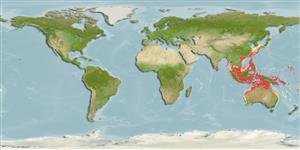Common names from other countries
>
Ovalentaria/misc (Various families in series Ovalentaria) >
Opistognathidae (Jawfishes)
Etymology: Opistognathus: Greek, opisthe = behind + Greek, gnathos = jaw (Ref. 45335); to the very elongate upper jaw of the type species of the genus, Opistognathus nigromarginatus (Ref. 128653); castelnaui: Named for the French diplomat and ichthyologist Francis-Louis de Castelnau (1812-1880)..
More on author: Bleeker.
Environment: milieu / climate zone / depth range / distribution range
Sinh thái học
Biển gần đáy; Mức độ sâu 20 - 100 m (Ref. 559). Tropical
Indo-West Pacific: eastern Australia to the Ryukyus, Taiwan, Philippines, Malaysia, and Indonesia.
Bộ gần gũi / Khối lượng (Trọng lượng) / Age
Maturity: Lm ? range ? - ? cm
Max length : 25.0 cm SL con đực/không giới tính; (Ref. 559)
Các tia vây lưng cứng (tổng cộng) : 11; Các vây lưng mềm (tổng cộng) : 14; Tia cứng vây hậu môn: 3; Tia mềm vây hậu môn: 14; Động vật có xương sống: 28. This species is distinguished by the following characters: elongated supramaxilla and posterior end of maxilla produced as a thin flexible lamina; upper jaw's inner lining and adjacent membranes with one or two conspicuous black stripes; dorsal half of dorsal fin usually dark except for narrow pale margin, remainder of fin pale and often with 8 or 9 evenly spaced dark blotches that extend onto basal fourth to third of fin and slightly onto dorsum; D XI,14; body with about 90-11 0 oblique scale rows; total gill rakers 28-35 (Ref. 81517).
Inhabits open sand and rubble substrates in about 20-25 meters (Ref. 48637). May be found in depths greater than 100 m (Ref. 559). Mouthbrooders (Ref. 240).
Life cycle and mating behavior
Maturities | Sự tái sinh sản | Spawnings | Egg(s) | Fecundities | Ấu trùng
Employ mouthbrooding to care for their young (Ref. 240).
Smith-Vaniz, W.F., 2023. Review of Indo-West Pacific jawfishes (Opistognathus: Opistognathidae), with descriptions of 18 new species. Zootaxa 5252(1):1-180. (Ref. 128653)
IUCN Red List Status (Ref. 130435)
CITES (Ref. 128078)
Not Evaluated
Threat to humans
Harmless
Human uses
Các công cụ
Special reports
Download XML
Các nguồn internet
Estimates based on models
Preferred temperature (Ref.
115969): 24.1 - 28.5, mean 27.5 (based on 554 cells).
Phylogenetic diversity index (Ref.
82804): PD
50 = 0.5000 [Uniqueness, from 0.5 = low to 2.0 = high].
Bayesian length-weight: a=0.00389 (0.00180 - 0.00842), b=3.12 (2.94 - 3.30), in cm Total Length, based on all LWR estimates for this body shape (Ref.
93245).
Mức dinh dưỡng (Ref.
69278): 3.7 ±0.6 se; based on size and trophs of closest relatives
Fishing Vulnerability (Ref.
59153): Low vulnerability (21 of 100).
